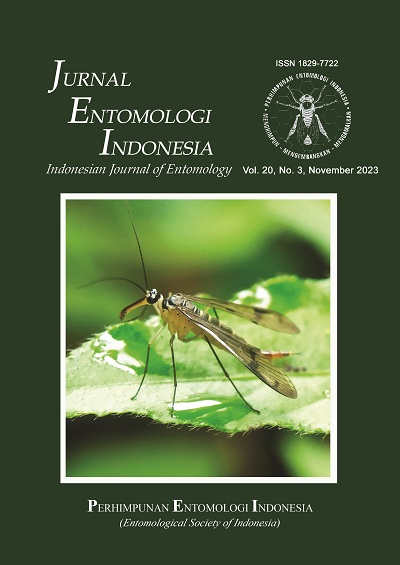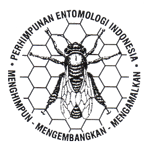Keanekaragaman beserta karakteristik habitat Famili Panorpidae (Ordo: Mecoptera) di Taman Hutan Raya Ir. H. Djuanda Bandung
Diversity and habitat characteristic of Panorpidae family (Order: Mecoptera) in Taman Hutan Raya Ir. H. Djuanda Bandung
DOI:
https://doi.org/10.5994/jei.19.3.213Keywords:
abundance, city forest, population distribution, PanorpidaeAbstract
Mecoptera is a primitive and minor order of insects with nine families, including Panorpidae. Research on Panorpidae in Indonesia is lacking, especially regarding its habitat. Thus, the purpose of this study was to observe the diversity and habitat characteristics of Panorpidae. The study was conducted at Taman Hutan Raya Ir. H. Djuanda Bandung from March to April 2023. The survey method was conducted at plots in three area blocks: the utilization block, the protection block, and the collection block. Panorpidae were collected by hand and sweeping net and then identified based on morphological characteristics. Temperature, humidity, light intensity, and vegetation where Mecoptera are found are identified and recorded. This study collected one genus (Neopanorpa) and five species found in the protection block (there were five species) and the utilization block (there were three species) while none in the collection block. The Penorpidae population was higher at the Protection block than at the Utilization block. Generally, Panorpidae was found in broad-leaf vegetation such as Clidemia sp. and Datura sp., with a canopy that is not too dense. The level of diversity and evenness of both areas was medium. Humidity positively affects the diversity and abundance of Panorpidae, while temperature and light intensity have negative effects. This research shows that Panorpidae likes damp places protected by bush vegetation and under not too dense canopy.
Downloads
References
Bicha WJ. 2015. The scorpionflies (Mecoptera) of Indochina with the description of new species of Bittacus and Neopanorpa. Proceedings of the Entomological Society of Washington. 117: 435–451. DOI: https://doi.org/10.4289/0013-8797.117.4.435.
Bicha W. 2006. New scorpionflies (Mecoptera: Panorpidae) from Jalisco, Michoacán, and Oaxaca, Mexico. Proceedings of the Entomological Society of Washington. 108:24–34.
Bicha WJ. 2019. Scorpionflies (Mecoptera: Panorpidae) Collected during project tiger with the description of three new species from Thailand. The Pan-Pacific Entomologist. 95:49–63. DOI: https://doi.org/10.3956/2019-95.2.49.
Bicha WJ. 2018. Biodiversity of Mecoptera. In: Foottit RG, Adler PH (Eds.), Insect Biodiversity: Science and Society. Volume 2. pp. 705–720. Hoboken: Wiley. DOI: https://doi.org/10.1002/9781118945582.ch23.
Byers GW. 2009. Mecoptera: Scorpionflies, Hangingflies. In: Encyclopedia of Insects. pp. 611–614. Elsevier Inc. DOI: https://doi.org/10.1016/B978-0-12-374144-8.00170-3.
Gotelli NJ, Colwell RK. 2011. Estimating species richness. In: Magurran AE, McGill BJ (Eds.), Biological Diversity: Frontiers in Measurement and Assessment. pp. 39–54. New York: Oxford University Press.
Hu GL, Hua Y, Hebert PDN, Hua BZ. 2019. Evolutionary history of the scorpionfly Dicerapanorpa magna (Mecoptera, Panorpidae). Zoologica Scripta. 48:93–105. DOI: https://doi.org/10.1111/zsc.12326.
Hu GL, Hua BZ. 2020. Review of the scorpionfly Genus Dicerapanorpa Zhong & Hua (Mecoptera: Panorpidae), with descriptions of two new spesies. European Journal of Taxonomy. 711: 1–13. DOI: https://doi.org/10.5852/ejt.2020.711.
Jiang L, Hua BZ. 2015. Morphological comparison of the larvae of Panorpa obtusa Cheng and Neopanorpa lui Chou & Ran (Mecoptera: Panorpidae). Zoologischer Anzeiger. 255:62–70. DOI: https://doi.org/10.1016/j.jcz.2015.02.004.
Letardi A. 2022. The new checklist of the Italian fauna: Mecoptera. Biogeographia –The Journal of Integrative Biogeography. 37:ucl002. DOI: https://doi.org/10.21426/B637156506.
Miao Y, Wang JS, Hua BZ. 2018. Molecular phylogeny of the scorpionflies Panorpidae (Insecta: Mecoptera) and chromosomal evolution. Cladistics. 35:385–400. DOI: https://doi.org/10.1111/cla.12357.
Mishin IN. 2022. Dynamics of population change, pollinators biodiversity and their role in managing the sustainability of biocenosis. IOP Conference Series: Earth and Environmental Science 1045:012157. DOI: https://doi.org/10.1088/1755-1315/1045/1/012157.
Ortloff A, Albornoz S, Romero M, Vivallo G. 2016. Skin artefacts due to post-mortem damage caused by Notiothauma reedi: A insect of forensic importance in forest communities of Chile. Egyptian Journal of Forensic Sciences. 6:411–415. DOI: https://doi.org/10.1016/j.ejfs.2016.06.006.
Penny ND, Byers GW. 1979. A check-list of the Mecoptera of the world. ACTA Amazonica. 9: 365–388. DOI: https://doi.org/10.1590/1809-43921979092365.
Rahmafitria F, Hindayani P. 2022. Integrasi analisis preferensi visual dan bahaya lanskap dalam perencanaan wisata Taman Hutan Raya Ir. H. Djuanda, Bandung. Jurnal Lanskap Indonesia. 14:60–68. DOI: https://doi.org/10.29244/jli.v14i2.39833.
Su J, Liu W, Hu F, Miao P, Xing L, Hua Y. 2023. The distribution pattern and species richness of Scorpionflies (Mecoptera: Panorpidae). Insects. 14:332. DOI: https://doi.org/10.3390/insects14040332.
Tan J, Hua B. 2009. Terrobittacus, a new genus of the Chinese Bittacidae (Mecoptera) with descriptions of two new species. Journal of Natural History. 43:2937–2954. DOI: https://doi.org/10.1080/00222930903359628.
Thornhill R. 2016. Competition and coexistence among Panorpa Scorpionflies (Mecoptera: Panorpidae). Ecological Monograph. 50:179–197. DOI: https://doi.org/10.2307/1942478.
Tong X, Zhong W, Hua BZ. 2018. Copulatory mechanism and functional morphology of genitalia and anal horn of the scorpionfly Cerapanorpa dubia (Mecoptera: Panorpidae). Journal of Morphology. 279:1532–1539. DOI: https://doi.org/10.1002/jmor.20903.
Utami I, Putra. 2020. Ekologi Kuantitatif: Metode Sampling dan Analisis Data Lapangan. Yogyakarta: K-Media.
Wahyuningsih E, Faridah E, Budiadi, Syahbudir A. 2019. Komposisi dan keanekaragaman tumbuhan pada habitat ketak (Lygodium circinatum (Burn. (Sw.) di Pulau Lombok, Nusa Tenggara Barat. Jurnal Hutan Tropis. 7:92–105.
Wang JS, Hua BZ. 2019. Taxonomy of the Genus Neopanorpa van der Weele, 1909 (Mecoptera, panorpidae) from the oriental region, with the description of two new species. European Journal of Taxonomy. 543:1–17. DOI: https://doi.org/10.5852/ejt.2019.543.
Wang JS, Hua BZ. 2020. Taxonomic revision and phylogenetic analysis of the enigmatic scorpionfly Genus Leptopanorpa MacLachlan (Mecoptera: Panorpidae). Journal of Zoological Systematics and Evolutionary Research. 58:900–928. DOI: https://doi.org/10.1111/jzs.12363.
Wang JS, Hua BZ. 2022a. A Color Atlas of The Chinese Mecoptera. Singapore: Springer Nature Singapore. DOI: https://doi.org/10.1007/978-981-16-9558-2.
Wang PY, Hua BZ. 2022b. Elevational diversity pattern and allochronic divergence of scorpionflies in the Qinling mountains. Ecological Indicators. 134:108500 DOI: https://doi.org/10.1016/j.ecolind.2021.108500.
Downloads
Published
How to Cite
Issue
Section
License
Copyright (c) 2023 Putry Ardyanty, Ana Widiana, Ida Kinasih

This work is licensed under a Creative Commons Attribution 4.0 International License.
Authors who publish with this journal agree to the following terms:
- Authors retain copyright and grant the journal right of first publication with the work simultaneously licensed under a Creative Commons Attribution 4.0 International License that allows others to share the work with an acknowledgement of the work's authorship and initial publication in this journal.
- Authors are able to enter into separate, additional contractual arrangements for the non-exclusive distribution of the journal's published version of the work (e.g., post it to an institutional repository or publish it in a book), with an acknowledgement of its initial publication in this journal.
- Authors are permitted and encouraged to post their work online (e.g., in institutional repositories or on their website) prior to and during the submission process, as it can lead to productive exchanges, as well as earlier and greater citation of published work (See The Effect of Open Access).








